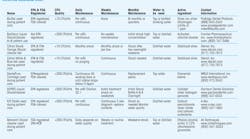by Lynne Slim, RDH, BSDH, MSDH
All of us have experienced uncomfortable clinical scenarios from time to time, but this one, in particular, made me feel a bit prickly and unsure of myself. I was working a part-time clinical hygiene position that was going nowhere and I was getting ready to give notice to my dentist employer because he failed to meet the promises he made when he hired me.
Adult patients were being scheduled every 60 minutes, and the male receptionist (who was the son of the employer) was being asked by him to slip in extra patients during the 60-minute time slot. Needless to say, I couldn't get out of there fast enough.
Before I left the practice for good, I faced several challenges on my schedule, and one involved a frail, elderly woman as a new patient. She was escorted by a certified nursing assistant (CNA), and the two of us had never spoken nor did she give me any information about the patient. Not knowing what to expect (remember, this was not an ideal practice), I allowed the CNA to seat the patient. It only took me a couple of minutes to realize that I did not have the skill set required to take to care of this patient. She was hostile, hallucinating, and restless, and I very gently told the CNA that all I could offer at this point was an in-service at the patient's nursing home once I received training on how to work with patients with severe cognitive impairment.
Last March, I was working a booth for an instrument company at the Hinman Dental Meeting, and I had the good fortune to meet Pat Poole, PN, RDH, BSDH, MS. Pat is part-time faculty at the University of North Carolina School of Dentistry, and her background includes working with dementia patients in a nursing home as a nursing assistant and in a hospital setting as an LPN. Since 2010, she has been working part-time with The Program on Aging, Disability and Long-term Care at The Cecil G. Sheps Center for Health Services Research as a research associate.
There's an old saying: "You don't know what you don't know." How true it is, especially when it comes to treating patients with an advanced cognitive impairment such as dementia. I'm beginning to learn from Pat the skills and nuances required to treat these patients successfully and would like to share some of her suggestions with you.
------------------------------------------------
Other articles by Lynne Slim
------------------------------------------------
Oral care for dementia patients isn't just about debris and biofilm removal. Prerequisites for providing oral health-care include advanced education in geriatric dentistry and continuing education in caring for dementia patients at home or in nursing facilities. Pat had, in addition to her nursing credentials, a gerontology externship while in training for her BSDH and MS degree at the dental school, and she is presently participating in several research projects involving geriatric oral care with the Cecil G. Sheps Center on Aging. Part of her collaboration with other health-care providers at Sheps included co-authoring a training DVD titled "Mouth Care Without a Battle."
Pat and her professional colleagues with whom she collaborated on the training DVD explain how poor oral health affects systemic health, and they emphasize the association between poor oral health and pneumonia among high-risk elderly adults living in nursing homes and those in ICUs. Research concerning the strength of this association is ongoing, but there is already an understanding (based on best available evidence to date) that aspiration of respiratory pathogens shed from oral biofilms into the lower airway increases the risk of developing a lung infection. A recent systematic review and meta-analysis of randomized trials evaluating ventilator-associated pneumonia emphasized the need for more research to determine if toothbrushing has the potential to decrease ventilator-associated pneumonia.1
Regular oral hygiene care provision is challenging for cognitively impaired individuals for a number of reasons. Providers of oral care must be armed with the appropriate communication skills based on the level of cognitive decline, and there's a learning curve.
Pat believes in relating emotionally and warmly with dementia patients in order to open the door to success. Arguing and proving through logic doesn't work, and each patient's malfunction is unique. The most effective approaches to successful management involve individualized interventions in the moment, and there's a creative component. Connection might involve holding a precious family photo or applying lipstick to a female patient's lips (especially one who wore it everyday for many decades), joining in singing a familiar song or hymn, or gently rubbing your hand across the patient's face.
Knowing a patient's medical and personal history is critical too, especially medical conditions and medications, and whether or not they are at risk for aspiration. Most patients in the latter stages of dementia are at risk for aspiration. The misdirection of oropharyngeal secretions of gastric contents into the larynx and lower respiratory tract (aspiration) can lead to aspiration pneumonia which is an independent predictor of mortality.
If you are treating a dementia patient in private practice, ask the nursing facility to send a brief history of the patient's health issues and medications. If you find yourself treating a patient in a nursing home setting, check the resident's chart at the nurses' station and talk with their assigned caregiver before treating the patient.
For patients with advanced cognitive impairment, it's important to enter their reality. They may truly believe that you are an imposter, and they don't know who they can trust. Like a child in a crowd of strangers, they don't comprehend who is safe and who is not. Developing a relationship with a stranger involves connection on different levels and you can find caregiver fact and tip sheets online (www.caregiver.org).
Pat and her colleagues at the Sheps Center have developed basic oral care standards for patients with teeth and for those with dentures.
The instructions on the DVD are specifically developed for CNA caregivers, and they include infection control. CNAs admit in research studies that they don't know much about oral care delivery. In one pilot study in New Hampshire, mouth care for dentate elderly nursing home residents was described.2 Oral care standards were developed by dentists, dental hygienists, and registered nurses, and adherence to these standards was low, ranging from a high of 16% to a low of 0%. In addition, most residents (63%) who received assistance resisted CNA approaches.2
Teaching CNAs and nurses various techniques and protocols is time-consuming but well worth the effort, and any standards developed for nursing homes must be evaluated on a regular basis.
There's generally a lack of accountability structure for oral care, and a weak commitment on the part of nursing supervisors. When CNAs are pressed for time, the first thing to go is oral care. To improve accountability, we need to inform our patients and senior citizen organizations of the importance of providing daily oral hygiene care to our loved ones in long-term health-care or hospice care facilities. Their mouths must be checked to confirm that this is being done and, if not, a written complaint should be filed with the administrators requesting the care.
In listening to the two-part DVD on meeting oral care needs of individuals with cognitive or physical impairment, reading articles online and talking to Pat, I realized very quickly that dental hygienists are in a perfect position to provide direct care and leadership in educating CNAs and other health-care team members in skilled nursing facilities.
I'd love to hear from the many other RDHs who are working in these positions around the United States and abroad. I sincerely applaud your dedication to caring for the oral health-care needs of this important and often neglected segment of the U.S. population. For more information about individualized mouth care for persons with cognitive impairment, you can reach Pat at: pat [email protected].
Finally, Pat presents a seminar titled, "Oral Care and Dementia: How to Recognize Dementia and Successfully Deliver Treatment" and she welcomes speaking engagements. RDH
LYNNE SLIM, RDH, BSDH, MSDH, is an awardwinning writer who has published extensively in dental/dental hygiene journals. Lynne is the CEO of Perio C Dent, a dental practice management company that specializes in the incorporation of conservative periodontal therapy into the hygiene department of dental practices. Lynne is also the owner and moderator of the periotherapist yahoo group: www.yahoogroups.com/group/periotherapist. Lynne speaks on the topic of conservative periodontal therapy and other dental hygiene-related topics. She can be reached at [email protected] or www.periocdent.com.
References
1. Alhazzani W, Smith O, Muscedere J, Medd J, Cook D. Toothbrushing for critically ill mechanically ventilated patients: a systematic review and meta-analysis of randomized trials evaluating ventilator-associated pneumonia.
Crit Care Med 2013 Feb; 41(2): 646-55.
2. Coleman P, Watson NM. Oral care provided by certified nursing assistants in nursing homes. J Am Geriatr Soc. 2006 Jan; 54(1): 138-43.
Techniques and products that make a difference are presented and explained in the DVD series. Basic mouth care consists of five components: food removal, toothbrushing, interdental cleaning, tongue cleaning, and the application of topical fluoride. Each component is covered extensively and some of the suggested products/techniques can be viewed on the "Mouth Care Without a Battle" website (www.mouthcarewithoutabattle.org). Some of the most important insights that I gained from talking to Pat and from the DVD series are:
- Patients with aspiration precautions should not use toothpaste; alcohol-free CHX is a great alternative and caregivers can dip the toothbrush into about 15 ML of rinse in a medicine cup (Tap off the excess and then brush). Only use CHX for six weeks then switch to an OTC antimicrobial rinse.
- Interdental brushes with angled brush heads are easier for caregivers to maneuver in a mouth.
- "Jiggle/sweep" instructions for soft toothbrushing technique seems to be well-accepted by caregivers such as certified nursing assistants.
- When performing a toothbrush prophy, patients sometimes like to do the work themselves. After they are finished, you can go back and complete the task, focusing on areas missed. Always ask the patient's permission to perform care and constantly inform them about what you are doing.
- After rinsing toothbrush and interdental brush under running water to remove all debris and product residue, dip both brushes into a one ounce cup of antimicrobial rinse and soak for 30 seconds. Dry brushes and cover toothbrush with an appropriate toothbrush cover.
- For patients who resist mouth care, besides using a personal, creative approach, gently touch the lip with the toothbrush prior to brushing.
- Using two toothbrushes, the handle of one can be used (preferably with soft handle) as a mouth prop and some toothbrushes have tongue cleaners on the backside of the head.
- When patient bites on the brush try gently massaging at the TMJ or place your finger wrapped in gauze soaked with antimicrobial rinse and massage the buccal side of the upper teeth or buccal mucosa. Once this is done, the patient will more than likely release. (When the finger is on the buccal surface of the upper teeth, the patient cannot bite the caregiver.)
- Keep in mind that many elderly patients do not like mint flavors so another flavor such as fruit may be more pleasant.
- Apply fluoride paste with cotton tipped applicator at gumline.
Past RDH Issues







